Unveiling the Unique Features of the Poison Ocellate Mototi Octopus
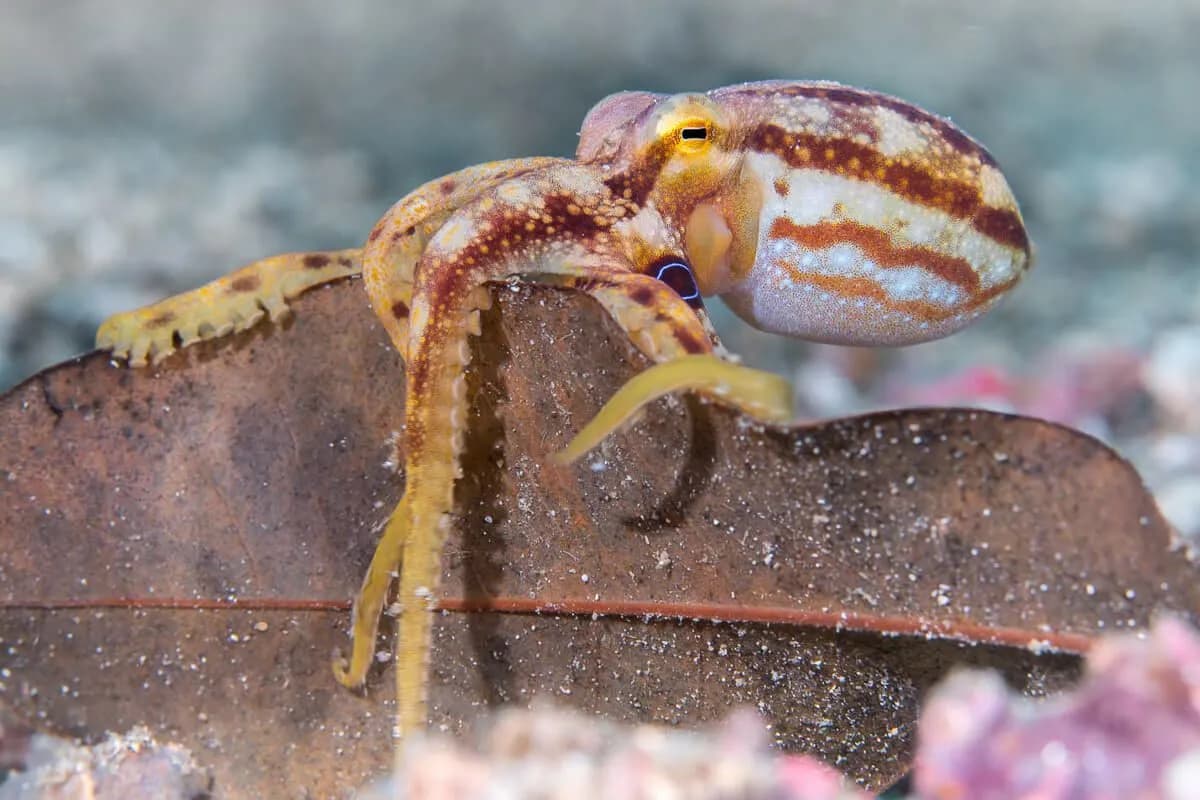
The Lembeh Strait is well known for its abundance of rare and unusual marine life and while many are widely known as ‘iconic species’ (think blue ring and coconut octopus or pygmy seahorses), some of the rarest critters are not as well known among the diving community. One of these critters is a tiny cephalopod – the Mototi Octopus. In this article we will take a look at this very special critter in more detail.
It’s All in a Name

The first species of mototi octopus was discovered in 1999 around Rapa Island, French Polynesia where the species is referred to locally as ‘fe’e mototi’. The literal translation of fe’e is octopus and mototi means poisonous. The scientific name is Amphioctopus mototi.
The Unique Behavior of the Mototi Octopus
![]()
Sightings of the mototi octopus are rare so there is still a lot to learn about their behavioral habits. They are also a very secretive and solitary species so we continue to learn more and more with every sighting.
In Lembeh, we most often spot mototis at our rubble and combination dive sites which afford them crevices created by the coral rubble and rocks to secrete themselves in to. They are also seen at some of our black sand muck diving sites where they appear to prefer to hide themselves inside bottles, cans, and other manmade objects, as well as inside bi-valve shells rather than burying into the sand like other octopus species.
We see mototis in the Lembeh Strait at depths from just 5 meters to 25 meters.
What are Ocelli?
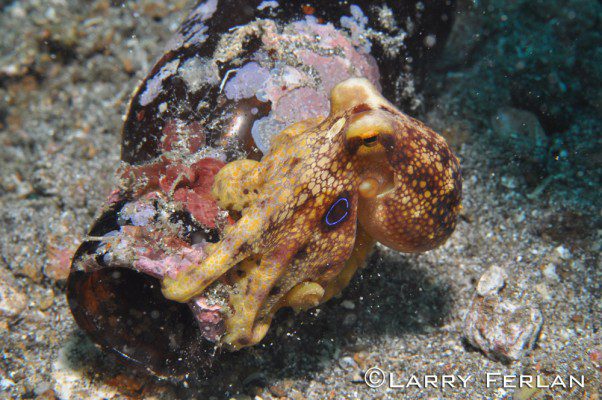
The mototi is an ocellate octopus, the defining feature of which is the presence of ‘ocelli’. Ocelli are also known as ‘fake eyes’. Ocelli are positioned mid-way between the octopuses eyes and its arms (usually between the second and third arm). In the mototi octopus the ocellus is round and black, with an iridescent blue ring inside the black circle. It is these blue rings that often result in mototis being misidentified as blue-ring octopus.
Although the fake eyes are always present, they are not always visible, the visibility depends on the color of the octopuses skin at any one time. They are sometimes highly visible and at other times completely blended into the body coloration.
Mototi Camouflage and Defence Mechanisms
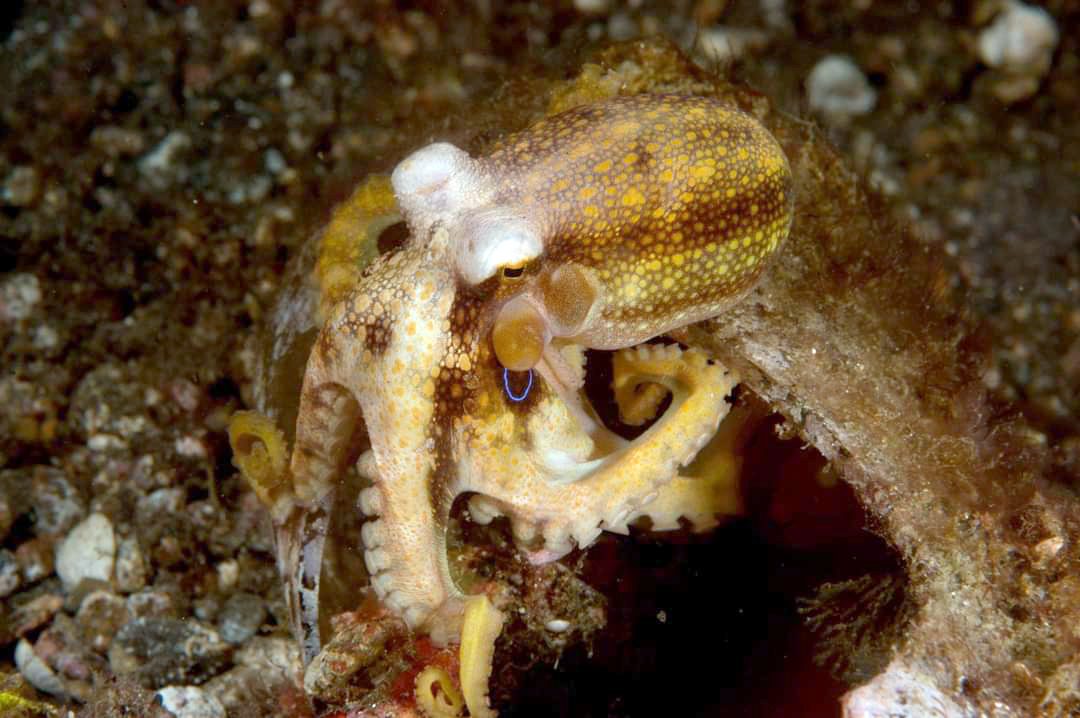
Like all octopus species the mototi octopus is capable of changing its skin color and texture to blend into its surroundings – and to ward off predators.
Normally, when resting, the coloration of this octopus is brown-orange and the ocelli are highly visible. If the octopus changes skin color to a light grey then the ocelli blend in and are barely visible.
When mototis become agitated or feel under threat, distinct dark brown stripes appear on their skin and their body color changes to yellowish beige (with visible occeli).
The false eyes (ocelli) of a mototi are part of their defence mechanism. The false eyes mislead predators as to the correct position of the mototis head and ‘real’ eyes, this can gain the mototi valuable time in which to counter attack or flee.
Mototi Venom
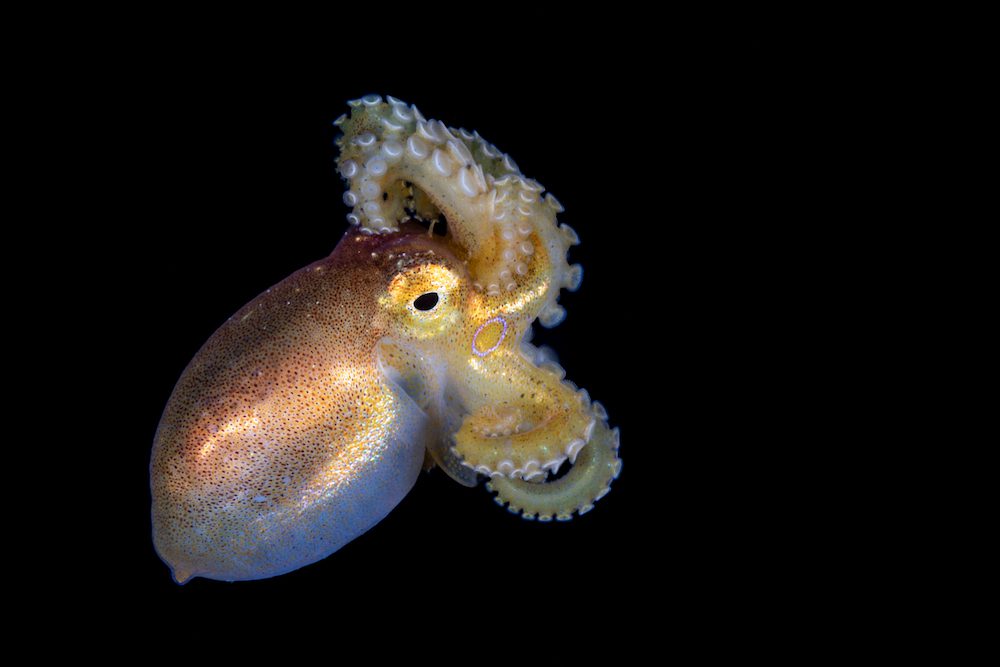
This is a stunning shot of a mototi octopus by Lilian Koh (see the small circle below the eye which is a characteristic of this species)
The mototi octopus is very similar to the blue ring octopus in terms of venom. Symbiotic bacteria in both the blue-ring’s and mototi’s salivary glands produce tetrodotoxin (TTX). This substance is potently neurotoxic, blocking the transmission of nerve impulses. TTX can kill a man within minutes, causing complete paralysis, loss of senses, and finally respiratory and cardiac arrest. The biggest problem is that, up to today, there is still no known antidote for TTX. The mototi octopus is thought to possess enough TTX to kill up to 20 adult humans – thankfully this is an extremely docile species that is known for fleeing from the human hand as opposed to attacking.
Best Dive Sites in Lembeh for Spotting the Mototi Octopus
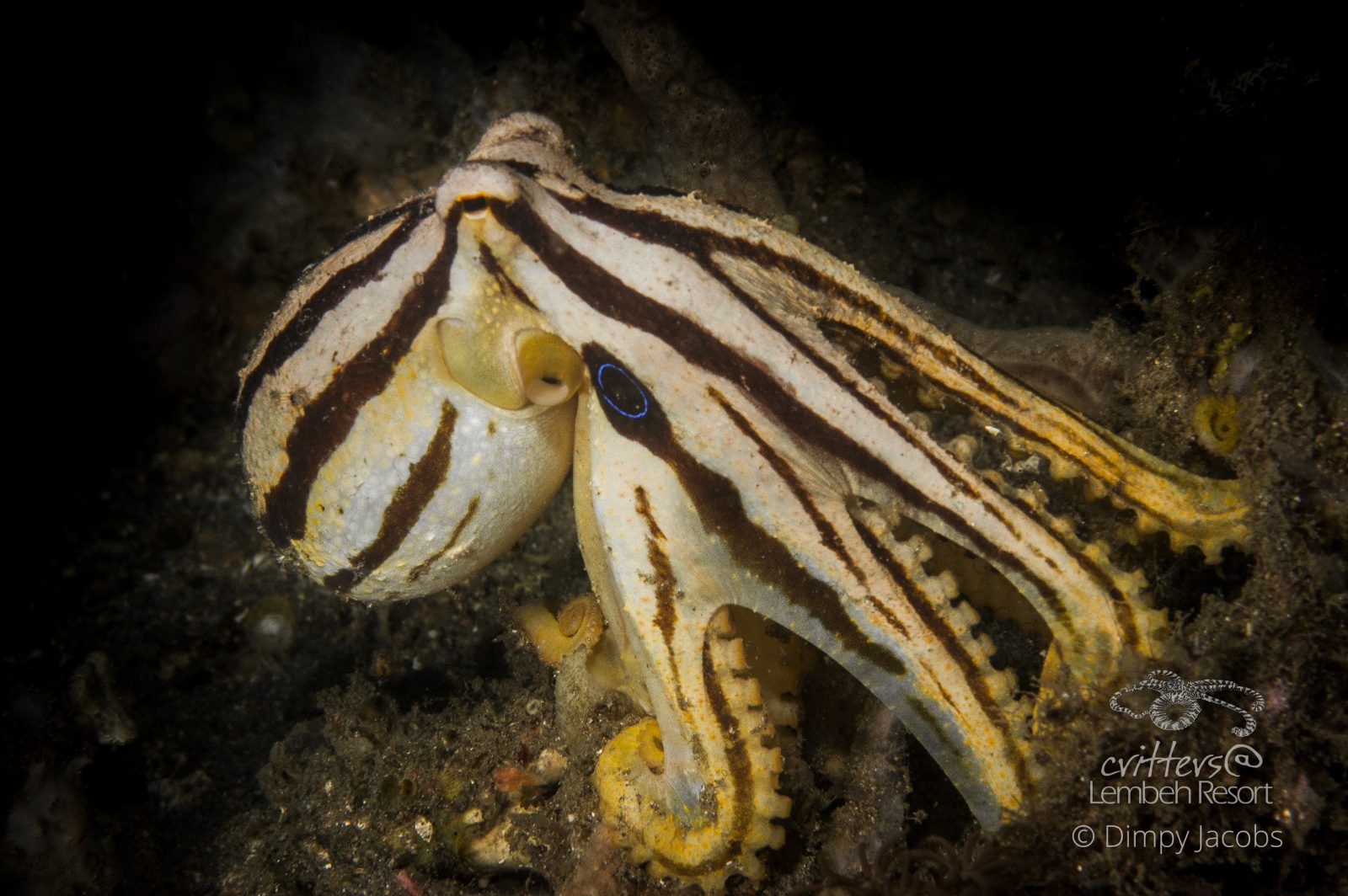
The best sites to see mototi in the Lembeh Strait are Air Prang, Jahir, and Hairball. It’s important to note though that like all critters in the Lembeh Strait, mototi octopus move around! Our dive guides are underwater every day and they know which sites are most productive for which species at any given time of year. If you would like to see a mototi during your stay, let your dive guide know!
Tips for Diving with and Photographing Mototi Octopus
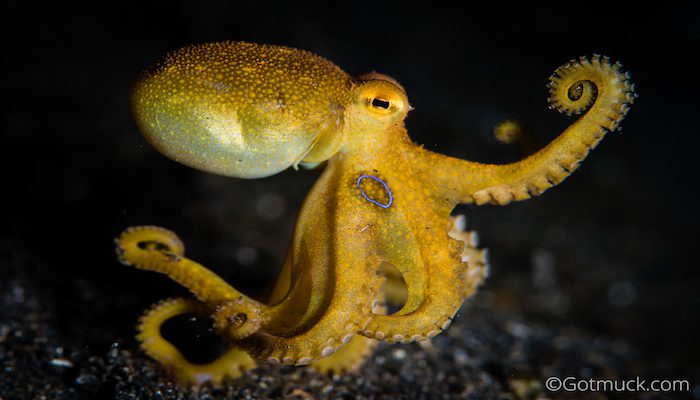
Due to the secretive and shy nature of the mototi, it is important to approach cautiously so as not to threaten them. A rushed approach will result in the mototi retreating and taking cover. Aim to position yourself close to the bottom – the higher up you are, the greater the perceived threat. Stay low and go slow!
If you are hoping to capture images of a mototi, approach in increments and shoot at each stage. Take your time and give the octopus time to get comfortable with you entering its space. By taking shots incrementally, if the octopus flees or takes cover, you will still have some images to work with.
Mototi Reproduction and Life Cycle
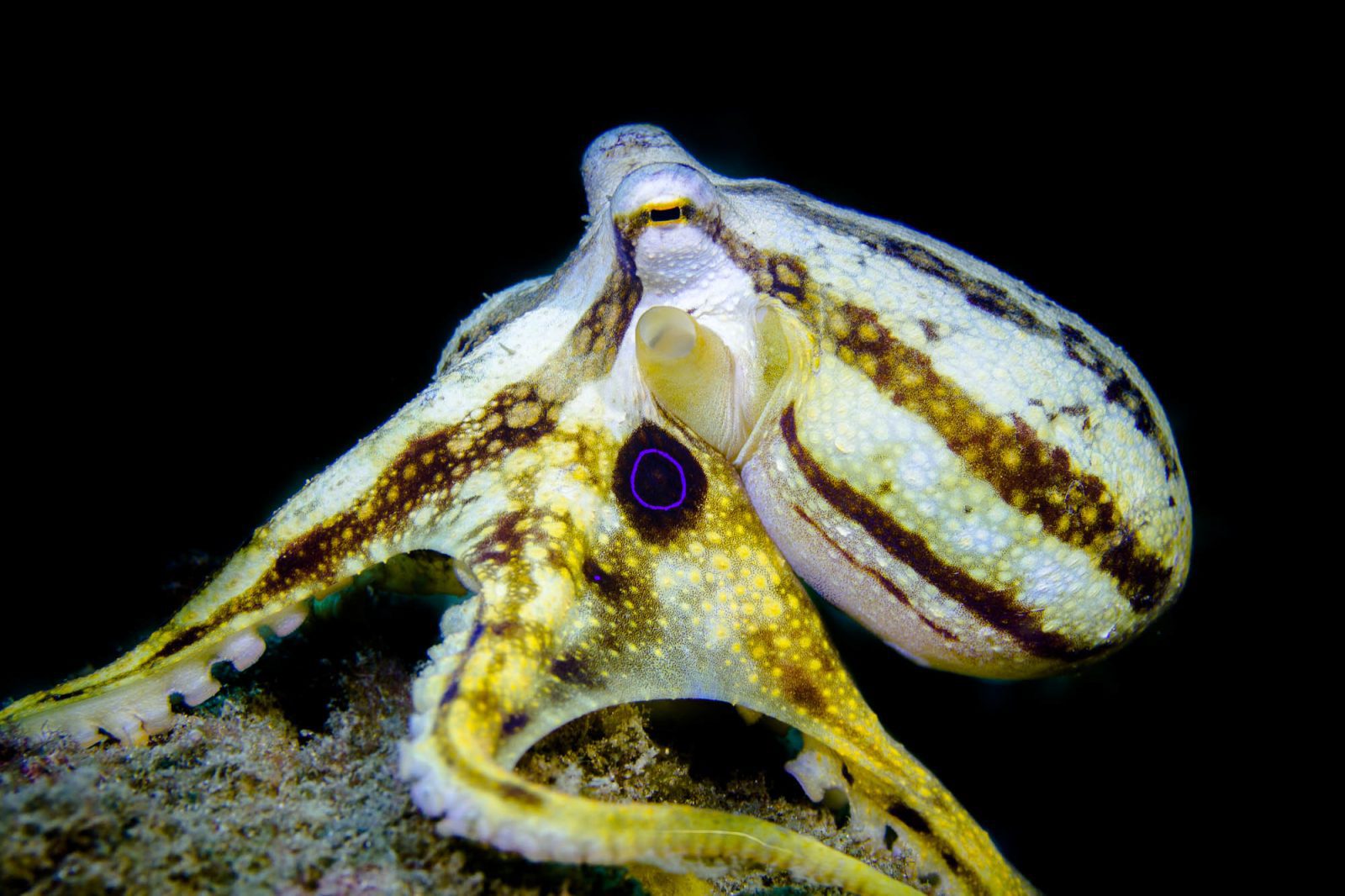
The mototi octopus was only discovered in 1999 and because of its secretive nature, there is still a lack of information regarding the reproductive and life cycle of this species.
Female mototis lay clutches of eggs, each of which measures around 1.7mm in length. She will lay her eggs underneath coral rubble or in crevices to keep them as hidden and safe as possible. Once the eggs hatch, mototi larvae drift with the ocean currents until they form into juveniles and then settle down on the reef.
When making blackwater dives in the Lembeh Strait we are often fortunate enough to spot mototi larvae drifting in the water column!
Stay with us at Lembeh Resort
 If you are ready to book your stay with us at Lembeh Resort or would like more information about our rates and availability contact us at reservations@LembehResort.com.
If you are ready to book your stay with us at Lembeh Resort or would like more information about our rates and availability contact us at reservations@LembehResort.com.
Further Reading?
If you enjoyed reading this article, you may also enjoy:



